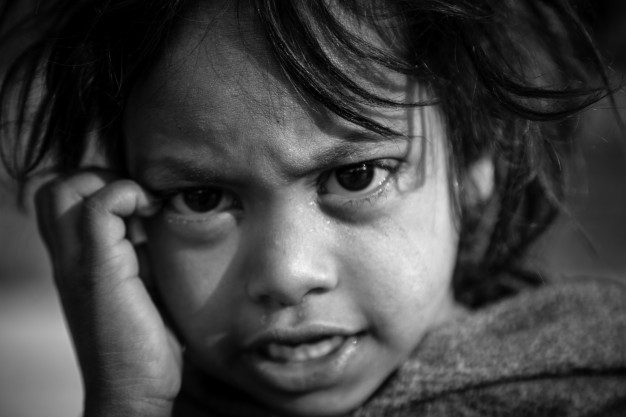Kwashiorkor, protein energy malnutrition, pitting oedema, protein rich and calorie dense diet
Description : Kwashiorkor is a type of malnutrition, generally affects the children within the age group of 1 to
Article Details :
Kwashiorkor is a type of malnutrition, generally affects the children within the age group of 1 to 4 years due to consuming a diet, which is extremely low in proteins. It is also known as edematous malnutrition as it is associated with developing edema especially in the belly, ankle and feet of children. It is a severe form of malnutrition and should be treated immediately otherwise it may become very severe in its manifestation.
History
Kwashiorkor is the local name of West Africa, which means ‘disease of the displaced child’. The term Kwashiorkor, was first commenced by Cicely Williams. Child who is unable to adapt the pressure of inadequate diet as well as the stress of separation from mother due to subsequent pregnancy is prone to develop Kwashiorkor. Thus it is referred as “disease the elder gets when the younger child is born”.
Prevalence
It is considered as one of the principal cause of increasing morbidity and mortality rate among children, worldwide. Though it is rare in United States but it is more prevalent among the children of Jamaica, Uganda, Central America, Congo, Puerto Rico, Southeast Asia and South Africa
Causes
- Prolong consumption of a diet that is deficit in protein as well as calorie
- Late weaning may cause deficiency of various nutrients and may lead to malnutrition
- Maternal malnutrition is associated with increasing the risk of giving birth a LBW (low birth weight) baby or underweight baby, who are more susceptible to develop kwashiorkor later in life
- Poor purchasing capacity is another cause of kwashiorkor. It is related with decreasing the quality and quantity of daily food intake, which causes severe malnutrition due to inadequate nourishment
Consequences of kwashiorkor
- Protein is an important nutrient requires for the overall growth and development of body. It also helps in resynthesizing cells and tissues that help to repair damages. As protein deficiency occurs in Kwashiorkor hence severe growth faltering occurs among children
- It has seen that concentration of albumin is decreased in blood, which affect the colloidal osmotic pressure hence results in fluid retention within tissues. This is generally called as edema. Edema, especially pitting edema develops first on the feet and leg of the children and eventually spreads all over the body
- Edema also develops in face thus the face looks puffy and this type of face is referred as “moon face”
- It hinders mental development as well. Children with kwashiorkor generally found irritable and restless
- Cognitive ability of children is also affected
- The hair becomes dry, thin and easily pluckable
- Skin becomes pigmented
- Due to protein deficiency it has seen that activities of digestive enzymes are decreased that affect the normal digestion procedure adversely
- Intestinal epithelial cells are atrophied due to prolong deficiency of protein, which ultimately decrease the absorption of nutrients. Mal-absorption is associated with developing multi deficiency disorders that further more worsen the condition
- Atrophy of heart also occurred due to poor growth of cardiac muscle, which is associated with decreasing cardiac output and blood circulation
- It also affects the renal system. It has seen that the glomerular filtration rate (GFR) is decreased due to decreased cardiac output and dehydration
- Poor protein status of the body significantly reduces immunological responses that make the defense mechanism poorer as a result children with kwashiorkor become more susceptible to infections
- Increased risk of infection also increases the prevalence of diarrhoea that leads to electrolyte imbalance
- Weight reduction occurred
- Muscle wasting also occurred
Nutritional management
Proper nutritional support is considered as one of the most effective remedial action for preventing kwashiorkor. Consumption of a diet rich in protein as well as calorie is the best therapeutic option for reducing its consequences as it helps to fulfill the immediate demand of the body and also helps to promote catch up growth.
Below points will provide an overview of the diet and pattern of nutrition, which is essentially required for improving the symptoms of kwashiorkor –
Energy
- It is better to provide 150 to 175 Kcal of energy per kg of ideal body weight to the effected child in regular manner
- While preparing diets for kwashiorkor children it should be kept in mind that the diet must be rich in calorie and the calorie should come from carbohydrate (mainly) and fat otherwise the body will utilize protein for energy purpose rather than using it for anabolic or growth reason
- It is better to include malted cereals in their diet as it helps to increases the calorie density
Protein
- Protein is the most important nutrient requires for preventing this severe malnutrition
- 10% of total calorie should came from proteins if it is derived from animal sources, whereas if the protein is obtained from plant sources then the protein consumption should be 13 to 14% of total calorie intake
- It is better to Read more



